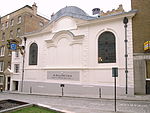Company of Watermen and Lightermen

The Company of Watermen and Lightermen (CWL) is a historic City guild in the City of London. However, unlike the city's other 109 livery companies, CWL does not have a grant of livery. Its meeting rooms are at Waterman's Hall on St Mary at Hill, London. The role of watermen was to transfer passengers, while lightermen moved goods and cargo, between the Port of London and vessels moored in the River Thames. Although modern river workers are licensed by the Maritime and Coastguard Agency, the Company continues its roles arranging apprenticeships, lobbying on river matters, and organising historic annual events and ceremonies. The company's clerk is Julie Lithgow, formerly director of the Institute of Chartered Shipbrokers.
Excerpt from the Wikipedia article Company of Watermen and Lightermen (License: CC BY-SA 3.0, Authors, Images).Company of Watermen and Lightermen
Billingsgate Walk, City of London
Geographical coordinates (GPS) Address Website Nearby Places Show on map
Geographical coordinates (GPS)
| Latitude | Longitude |
|---|---|
| N 51.509 ° | E -0.084 ° |
Address
Billingsgate Walk
EC3R 6DX City of London
England, United Kingdom
Open on Google Maps











